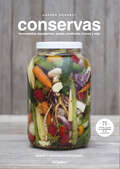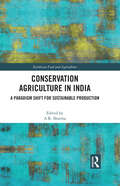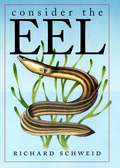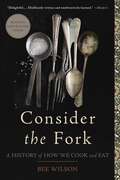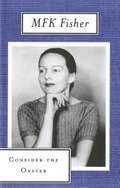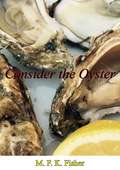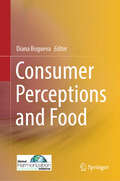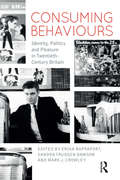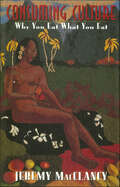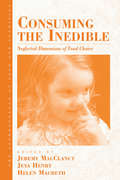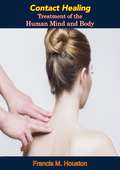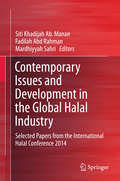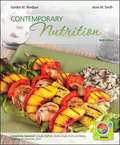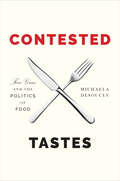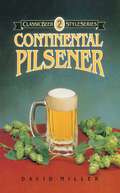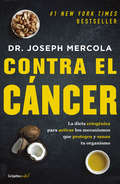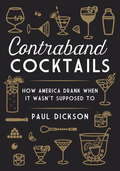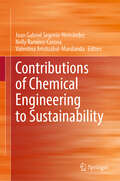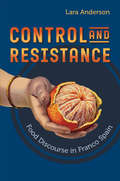- Table View
- List View
Conservas: Fermentados, escabeches, salsas, confituras, licores y más
by Mauricio PizardEste manual nos enseña las técnicas básicas para realizar 75 distintas conservas y fermentaciones con productos de las 4 estaciones del año. Un libro con un gran contenido fotográfico y diseño cuidado que nos enseñará el paso a paso de estás técnicas de conservación de alimento Conservas es el primer libro de conservas de Uruguay, con métodos seguros, recetas sencillas y un pequeño manual accesible, para poder guardar lo mejor de cada estación y disfrutar durante todo el año. Preparaciones clásicas, tradicionales, novedosas y de amigos invitados que nos ayudarán a consumir y participar de forma activa, inteligente y sustentable en nuestra propia alimentación. 75 recetas con más de 45 productos de las 4 estaciones, con referencias antropológicas e histórico-culturales. Fermentados y encurtidos, escabeches y vinagretas, salsas y concentrados, almíbares y mermeladas, pestos y terrinas, vinagres y licores, deshidratados y secados, y mucho más. Desde Garage Gourmet buscamos difundir y contagiar las ganas de cocinar y disfrutar comida casera, rescatando procedimientos y métodos que ponen en valor lo local y lo artesanal. Cuando la alimentación es un acto biológico, ambiental, político y cultural, preparar conservas caseras es ser activistas desde la cocina.
Conservation Agriculture in India: A Paradigm Shift for Sustainable Production (Earthscan Food and Agriculture)
by A. R. SharmaThis book examines the current situation, levels of adoption, management practices, and the future outlook of conservation agriculture in India, and also in other tropical and subtropical regions of the world. While conservation agriculture is proposed as an important means to combat climate change, improve crop productivity and food affordability, and to protect the environment, the adoption of conservation agriculture in India, and south-east Asia more broadly, has been slow. This volume reflects on the current status of conservation agriculture in India, asking why adoption has been slow and putting forward strategies to improve its uptake. The chapters cover the various aspects of crop management such as soil, water, nutrients, weeds, crop residues, machinery, and energy, in a range of environments, including irrigated and rainfed regions. The impact of climate change and the economic considerations behind the adoption of conservation agriculture are also discussed. The volume concludes by discussing the future outlook for conservation agriculture in India, in particular drawing out parallels with other tropical and subtropical regions of the world. This book will be of great interest to students and scholars of conservation agriculture, sustainable agriculture, crop and soil management, and environmental and natural resource management.
Consider the Eel
by Richard SchweidJournalist Richard Schweid first learned the strange facts of the freshwater eel's life from a fisherman in a small Spanish town just south of Valencia. "The eeler who explained the animal's life cycle to me did so as he served up an eel he had just taken from a trap, killed, cleaned, and cooked in olive oil in an earthenware dish," writes Schweid. "I ate it with a chunk of fresh, crusty bread. It was delicious. I was immediately fascinated." As this engaging culinary and natural history reveals, the humble eel is indeed an amazing creature. Every European and American eel begins its life in the Sargasso Sea--a vast, weedy stretch of deep Atlantic waters between Bermuda and the Azores. Larval eels drift for up to three years until they reach the rivers of North America or Europe, where they mature and live as long as two decades before returning to the Sargasso to mate and die. Eels have never been bred successfully in captivity.Consulting fisherfolk, cooks, and scientists, Schweid takes the reader on a global tour to reveal the economic and gastronomic importance of eel in places such as eastern North Carolina, Spain, Northern Ireland, England, and Japan. (While this rich yet mild-tasting fish has virtually disappeared from U.S. tables, over $2 billion worth of eel is still eagerly consumed in Europe and Asia each year.) The book also includes recipes, both historic and contemporary, for preparing eel.
Consider the Fork: A History of How We Cook and Eat
by Bee WilsonSince prehistory, humans have striven to tame fire and ice, and have braved the business ends of mashers, scrapers, and razor-sharp knives--all in the name of creating something delicious (or, at least, edible). The technology of food matters even when we barely notice it is there, but in recent years kitchen technology has become increasingly elaborate and eye-catching, transforming the old-fashioned home kitchen into a bristling stainless steel laboratory. Far from a new development, however, the modern kitchen is only the most recent iteration of an ancient lineage of food technology, as acclaimed food historian Bee Wilson reveals in Consider the Fork. Many of our technologies for preparing food have remained strikingly consistent for thousands of years. The Greeks and Romans already had pestles and mortars. Knives--perhaps mankind's most important gastronomic tool--predate the discovery of that other basic technology, fire. Other tools emerged quite suddenly (like the microwave, whose secrets were unlocked during radar tests conducted during World War II) or in fits and starts (like the fork, which had to endure centuries of ridicule before finally gaining widespread acceptance). For every technology that has endured, others have fallen by the wayside. We no longer feel the need for andirons and bastables, cider owls and dangle spits, even though in their day these would have seemed no more superfluous than our oil drizzlers and electric herb choppers. The evolution of food technology offers a unique window into human history, and Wilson blends history, science, and personal anecdotes as she traces the different technologies that have shaped--or slashed, pounded, whisked, or heated (and reheated)--our meals over the centuries. Along the way she reveals some fascinating facts--showing, for instance, how China's cuisine, its knives, and its eating utensils are all the product of the country's historically scarce fuel supply. To conserve energy, chefs rendered their ingredients quick-cooking by using large, multi-purpose chopping knives to reduce food to small, bite-sized morsels. This technique, in turn, gave rise to the chopstick, which cannot cut. What's more, the discovery of the knife--in Asia and elsewhere--was likely what gave humans our distinctive overbite. Before humans learned to fashion knives out of sharpened rocks, many of us cut our food by clamping it in our front teeth, which gave us perfectly aligned rows of teeth. But Wilson shows that, far from being adventurous innovators, cooks are a notoriously conservative bunch, and only adopt new technologies with great reluctance. The gas range revolutionized cooking when it was first introduced in the 19th century by promising to end "hearth deaths," a constant danger for women wearing billowing, flammable clothing. But indoor gas cooking--safer and more efficient--was nevertheless greeted with widespread suspicion when it was first introduced. Many chefs feared it would taint their food or poison their guests. The same hold true for the refrigerator, which was initially condemned as an unnatural technology that risked changing the fundamental "essence" of food. Perhaps the one exception to this technophobia, says Wilson, was the egg beater, new patents for which proliferated so astonishingly in late 19th-century America. In this fascinating history, Wilson reveals the myriad innovations that have shaped our diets today. An insightful look at how we've changed food and how food has changed us, Consider the Fork reveals the astonishing ways in which the implements we use in the kitchen affect what we eat, how we eat, and how we relate to food.
Consider the Oyster
by M. F. K. FisherM.F.K. Fisher, whom John Updike has called our "poet of the appetites," here pays tribute to that most delicate and enigmatic of foods---the oyster. As she tells of oysters found in stews, in soups, roasted, baked, fried, prepared agrave; la Rockefeller or au naturel--and of the pearls sometimes found therein--Fisher describes her mother's joy at encountering oyster loaf in a girls' dorm in the 1890's, recalls her own initiation into the "strange cold succulence" of raw oysters as a young woman in Marseille and Dijon, and explores both the bivalve's famed aphrodisiac properties and its equally notorious gut-wrenching powers. Plumbing the "dreadful but exciting" life of the oyster, Fisher invites readers to share in the comforts and delights that this delicate edible evokes, and enchants us along the way with her characteristically wise and witty prose.
Consider the Oyster
by M. F. K. FisherM. F. K. Fisher, whom John Updike has called our "poet of the appetites," here pays tribute to that most enigmatic of ocean creatures, the oyster. As she tells of oysters found in stews, in soups, roasted, baked, fried, prepared à la Rockefeller or au naturel--and of the pearls sometimes found therein--Fisher describes her mother's joy at encountering oyster loaf in a girls' dorm in the 1890s, recalls her own initiation into the "strange cold succulence" of raw oysters as a young woman in Marseille and Dijon, and explores both the bivalve's famed aphrodisiac properties and its equally notorious gut-wrenching powers. Plumbing the "dreadful but exciting" life of the oyster, Fisher invites readers to share in the comforts and delights that this delicate edible evokes, and enchants us along the way with her characteristically wise and witty prose."Consider the Oyster marks M. F. K. Fisher's emergence as a storyteller so confident that she can maneuver a reader through a narrative in which recipes enhance instead of interrupt the reader's attention to the tales. She approaches a recipe as a published dream or wish, and the stories she tells here...are also stories of the pleasures and disillusionments of dreams fulfilled."--PATRICIA STORACE, The New York Review of Books"Since Lewis Carroll no one had written charmingly about that indecisively sexed bivalve until Mrs. Fisher came along with her Consider the Oyster. Surely this will stand for some time as the most judicious treatment in English."--CLIFFTON FADIMAN
Consider the Turkey
by Peter SingerWhy this holiday season is a great time to rethink the traditional turkey feastA turkey is the centerpiece of countless Thanksgiving and Christmas dinners. Yet most of us know almost nothing about today&’s specially bred, commercially produced birds. In this brief book, bestselling author Peter Singer tells their story—and, unfortunately, it&’s not a happy one. Along the way, he also offers a brief history of the turkey and its consumption, ridicules the annual U.S. presidential &“pardon&” of a Thanksgiving turkey, and introduces us to &“a tremendously handsome, outgoing, and intelligent turkey&” named Cornelius. Above all, Singer explains how we can improve our holiday tables—for turkeys, people, and the planet—by liberating ourselves from the traditional turkey feast. In its place, he encourages us to consider trying a vegetarian alternative—or just serving the side dishes that many people already enjoy far more than turkey. Complete with some delicious recipes for turkey-free holiday feasting, Consider the Turkey will make you reconsider what you serve for your next holiday meal—or even tomorrow&’s dinner.
Consumer Perceptions and Food
by Diana BoguevaThis book is a timely overview of the various aspects of consumer perception related to food. This book explores consumer perceptions that are vital to marketers and often underlie the success or failure of products in the marketplace. Perception is the process of selecting, organizing, and interpreting sensations into a meaningful whole, and this book highlights how human perceptions are unique, highly subjective, and easily distorted. These perceptions are influenced by our senses—sight, hearing, taste, smell, and touch—as well as our beliefs, emotions, opinions, and experiences. This book states that this is related to food, and perceptions are also guided by beliefs, thoughts, emotions, feelings, and opinions about, or preferences, expectations, and knowledge of, and the sensory experience, the fear, and the relationships built between the consumers and the food over time. This book aims to further the understanding of the fundamental mechanisms which determine individual responses to existing and emerging food issues. This book provides insights into consumer behaviour (e.g. consumer decision making, promoting behaviour change), factors influencing consumers’ food and meal choices, confidence in the safety of food, perception of health-related messages and food laws and regulations, sustainable and responsible consumer behaviour (e.g. food waste), acceptability of new food alternatives, innovations and technologies, integrating consumer insight and communication challenges in cross-functional communications in innovation processes. "Consumer Perceptions and Food" delves into how these perceptions shape consumer behavior, from decision-making and behavior change to meal choices and confidence in food safety. It explores the impact of health-related messages, food laws, and regulations, and examines the acceptability of new food alternatives and technologies. The book also addresses the importance of sustainable and responsible consumer behavior, including food waste and ethical consumption. Through a rich array of insights, this book provides a deep understanding of the fundamental mechanisms that drive individual responses to food issues. It emphasizes the importance of mindful eating—making conscious food choices that benefit our health, the environment, and the planet. This involves considering the origins of our food, its production methods, and the broader impacts of our choices on public health and ecosystems. This book is a call to action for consumers to rethink their relationship with food, fostering deeper connections and appreciation for sustainable practices and ethical consumption. It is a crucial step in the ongoing journey of shaping the future of food, guided by informed and mindful consumers.
Consumers, Meat and Animal Products: Policies, Regulations and Marketing (Earthscan Food and Agriculture)
by Terence J. CentnerThis book addresses the production practices employed in the production of food animals and animal products that enable marketers to sell a variety of products to meet consumer demand. Food animal production practices have come under increased scrutiny by consumers who object to inputs and practices. The industry has been a proponent of using technologies to reduce production costs, resulting in lower-priced meat and animal food products, and now consumers are starting to look at other objectives. This book considers the key issues of concern to consumers, including the treatment of animals, the use of antibiotics, feed additives and hormones, and how these are monitored, regulated, and communicated to consumers. It also reviews labeling and information provided to consumers, including organic, genetic engineering, welfare standards, and place of origin. While the main focus is on the United States, there are descriptions of European practices and legislation. Overall, it aims to provide an objective and balanced appraisal, which will be of interest to advanced students and researchers in agricultural, food and environmental economics, law and policy, and animal production and welfare. It will also be very useful for early career professionals in the food and agricultural sectors.
Consuming Behaviours: Identity, Politics and Pleasure in Twentieth-Century Britain (Criminal Practice Ser.)
by Erika Rappaport Sandra Trudgen Dawson Mark J. CrowleyIn twentieth-century Britain, consumerism increasingly defined and redefined individual and social identities. New types of consumers emerged: the idealized working-class consumer, the African consumer and the teenager challenged the prominent position of the middle and upper-class female shopper. Linking politics and pleasure, Consuming Behaviours explores how individual consumers and groups reacted to changes in marketing, government control, popular leisure and the availability of consumer goods.From football to male fashion, tea to savings banks, leading scholars consider a wide range of products, ideas and services and how these were marketed to the British public through periods of imperial decline, economic instability, war, austerity and prosperity. The development of mass consumer society in Britain is examined in relation to the growing cultural hegemony and economic power of the United States, offering comparisons between British consumption patterns and those of other nations.Bridging the divide between historical and cultural studies approaches, Consuming Behaviours discusses what makes British consumer culture distinctive, while acknowledging how these consumer identities are inextricably a product of both Britain’s domestic history and its relationship with its Empire, with Europe and with the United States.
Consuming Culture: Why You Eat What You Eat
by Jeremy MacClancyWhy do some pregnant American women eat clay? Why do Cornish women blush at the mention of skate? What is the secret of a healthy diet in Papua New Guinea.Consuming Culture is about why we eat what we eat--and what our eating habits say about us. Original, witty, and provocative, this world tour of food cultures shows how food relates to sex, to the culinary snakes and ladders of meat versus vegetables, and to the often baffling rules of eating etiquette. The first book to investigate the human fascination with food, Consuming Culture explains how food makes friends or enemies of us all and why many societies, including our own, are obsessed with eating what is bad for them.Tell me what you eat and I'll tell you who you are," French gastronome Brillat-Savarine declared. To the Aboriginals of Australia it is fried witchetty grubs; to the Bameka of cameroon it is spiced cat stew. As this pioneering work demonstrates, the use of food in different cultures around the world is by turns perverse, fascinating, disquieting, and, above all, deeply revealing.From the psychology of supermarkets to the cuisine of trench warfare, from the diet industry to cannibalism, Consuming Culture gives valuable--and often hilarious--insight into the importance of food in our society. It will be an essential source of reference for life in the 1990s.
Consuming Identity: The Role of Food in Redefining the South (Race, Rhetoric, and Media Series)
by Ashli Quesinberry Stokes Wendy Atkins-SayreSoutherners love to talk food, quickly revealing likes and dislikes, regional preferences, and their own delicious stories. Because the topic often crosses lines of race, class, gender, and region, food supplies a common fuel to launch discussion. Consuming Identity sifts through the self-definitions, allegiances, and bonds made possible and strengthened through the theme of southern foodways. The book focuses on the role food plays in building identities, accounting for the messages food sends about who we are, how we see ourselves, and how we see others. While many volumes examine southern food, this one is the first to focus on food’s rhetorical qualities and the effect that it can have on culture.The volume examines southern food stories that speak to the identity of the region, explain how food helps to build identities, and explore how it enables cultural exchange. Food acts rhetorically, with what we choose to eat and serve sending distinct messages. It also serves a vital identity-building function, factoring heavily into our memories, narratives, and understanding of who we are. Finally, because food and the tales surrounding it are so important to southerners, the rhetoric of food offers a significant and meaningful way to open up dialogue in the region. By sharing and celebrating both foodways and the food itself, southerners are able to revel in shared histories and traditions. In this way individuals find a common language despite the divisions of race and class that continue to plague the South. The rich subject of southern fare serves up a significant starting point for understanding the powerful rhetorical potential of all food.
Consuming The Inedible
by Helen Macbeth Jeya Henry Jeremy M. MacclancyEveryday, millions of people eat earth, clay, nasal mucus, and similar substances. Yet food practices like these are strikingly understudied in a sustained, interdisciplinary manner. This book aims to correct this neglect. Contributors, utilizing anthropological, nutritional, biochemical, psychological and health-related perspectives, examine in a rigorously comparative manner the consumption of foods conventionally regarded as inedible by most Westerners. This book is both timely and significant because nutritionists and health care professionals are seldom aware of anthropological information on these food practices, and vice versa. Ranging across diversity of disciplines Consuming the Inedible surveys scientific and local views about the consequences - biological, mineral, social or spiritual - of these food practices, and probes to what extent we can generalize about them.
Contact Healing: Treatment of the Human Mind and Body
by Francis M. HoustonFirst published in 1958, this book outlines the complete therapy or treatment of the human mind and body. In the author Rev. Dr. Francis M. Houston’s own words, “the possibilities of this therapy in the field of healing seems limitless—study it carefully, treat with it sincerely and it will reward you richly.”
Contemporary Issues and Development in the Global Halal Industry: Selected Papers from the International Halal Conference 2014
by Siti Khadijah Ab. Manan Fadilah Abd Rahman Mardhiyyah SahriThis book features more than 50 papers presented at the International Halal Conference 2014, which was held in Istanbul and organised by the Academy of Contemporary Islamic Studies of Universiti Teknologi MARA. It addresses the challenges facing Muslims involved in halal industries in meeting the increasing global demand. The papers cover topics such as halal food, halal pharmaceuticals, halal cosmetics and personal care, halal logistics, halal testing and analysis and ethics in the halal industry. Overall, the volume offers a comprehensive point of view on Islamic principles relating to the halal business, industry, culture, food, safety, finance and other aspects of life. The contributors include experts from various disciplines who apply a variety of scientific research methodologies. They present perspectives that range from the experimental to the philosophical. This volume will appeal to scholars at all levels of qualification and experience who seek a clearer understanding of important issues in the halal industry.
Contemporary Japanese Restaurant Design
by Nacass Partners Motoko Jitsukawa Cornucopia K K.With evocative texts accompanying stunning photographs, Contemporary Japanese Restaurant Design features 28 of the most cutting-edge dining spaces by the country's leading restaurant designers.
Contemporary Nutrition
by Anne Smith Gordon WardlawContemporary Nutrition Seventh Edition is designed for students with little or no background in college-level biology, chemistry or physiology. It will provide students who lack a strong science background the ideal balance of reliable nutrition information and practical consumer-oriented knowledge. With their friendly writing style, the authors act as the student's personal guide to dispelling common misconceptions and to gaining a solid foundation for making informed nutrition choices.
Contemporary Nutrition 9th Edition
by Gordon M. Wardlaw Anne M. Smith Angela Collene"Contemporary Nutrition" is a complete and balanced resource for nutrition information written at a level non-science majors can understand. Completely revised and up-to-date with MyPlate, Healthy People 2020 and Dietary Guidelines for Americans, 2010, it provides the ideal balance of reliable nutrition information and practical consumer-oriented knowledge. With a friendly writing style, the authors act as the student's personal guide to dispelling common misconceptions and to gaining a solid foundation for making informed nutrition choices. "Contemporary Nutrition" emphasizes that a population consists of individuals with varying genetic and cultural backgrounds, and these individuals will have varying responses to diet. The knowledge gained from this text will allow students to personalize nutrition information and empower them to make better choices in their daily lives.
Contested Tastes: Foie Gras and the Politics of Food
by Michaela DesouceyWho cares about foie gras? As it turns out, many do. In the last decade, this French delicacy--the fattened liver of ducks or geese that have been force-fed through a tube--has been at the center of contentious battles between animal rights activists, artisanal farmers, industry groups, politicians, chefs, and foodies. In Contested Tastes, Michaela DeSoucey takes us to farms, restaurants, protests, and political hearings in both the United States and France to reveal why people care so passionately about foie gras--and why we should care too.Bringing together fieldwork, interviews, and materials from archives and the media on both sides of the Atlantic, DeSoucey offers a compelling look at the moral arguments and provocative actions of pro- and anti-foie gras forces. She combines personal stories with fair-minded analysis of the social contexts within which foie gras is loved and loathed. From the barns of rural southwest France and the headquarters of the European Union in Brussels, to exclusive New York City kitchens and the government offices of Chicago, DeSoucey demonstrates that the debates over foie gras involve heated and controversial politics. Her rich and nuanced account draws our attention to the cultural dynamics of markets, the multivocal nature of "gastropolitics," and the complexities of what it means to identify as a "moral" eater in today's food world.Investigating the causes and consequences of the foie gras wars, Contested Tastes illuminates the social significance of food and taste in the twenty-first century.
Contested Territory: Dien Bien Phu and the Making of Northwest Vietnam (Yale Agrarian Studies Series)
by Christian C. LentzThe definitive account of one of the most important battles of the twentieth century, and the Black River borderlands’ transformation into Northwest Vietnam This new work of historical and political geography ventures beyond the conventional framing of the Battle of Điện Biên Phủ, the 1954 conflict that toppled the French empire in Indochina. Tracking a longer period of anticolonial revolution and nation-state formation from 1945 to 1960, Christian Lentz argues that a Vietnamese elite constructed territory as a strategic form of rule. Engaging newly available archival sources, Lentz offers a novel conception of territory as a contingent outcome of spatial contests.
Continental Pilsener (Classic Beer Style Series)
by David MillerConsidered the father of all lagers, continental pilsener changed the course of brewing around the world. Noted author and brewer David Miller examines each country's version of pilsener, including ingredients and brewing stages. The Classic Beer Style Series, from Brewers Publications, examines individual world-class beer styles, covering origins, history, sensory profiles, brewing techniques and commercial examples.
Contra el cáncer
by Joseph MercolaLa dieta cetogénica para activar los mecanismos que protegen y sanan tu organismo. El descubrimiento científico de la década: la clave para prevenir y tratar el cáncer está en la mitocondria. Durante muchos años hemos aceptado que el cáncer es causado por malformaciones genéticas y daños en los cromosomas. Pero, ¿y si el cáncer, después de todo, no fuera una enfermedad genética? ¿Y si supieras que, en realidad, es causado por un desbalance metabólico producto de una disfunción mitocondrial? En este libro paradigmático, el primero en su tipo, el doctor Joseph Mercola nos explica por qué casi todas las enfermedades son causadas por procesos metabólicos disfuncionales. Con él comprenderás, de manera fácil y accesible, cómo funciona el cuerpo humano a nivel molecular y aprenderás a seguir un plan de alimentación cetogénica: una dieta baja en carbohidratos y alta en grasas saludables para optimizarlos procesos bioquímicos que suprimen la enfermedad y promueven la curación. Contra el cáncer, bestseller instantáneo en Estados Unidos, es ya el libro más vendido del gurú definitivo en el campo de la medicina natural: ¿qué esperas para sumarte a los miles de lectores que gracias a él han cambiado su vida?
Contraband Cocktails: How America Drank When It Wasn't Supposed To
by Paul DicksonAmericans weren't supposed to drink during Prohibition--but that's exactly when "cocktail culture" came roaring to life. The Bloody Mary, sleek cocktail shakers, craft mixology, and hundreds of other essentials of modern drinking owe their origins to the Dry Years. In Contraband Cocktails, Paul Dickson leads us on a fascinating tour of those years--from the "Man in the Green Hat" making secret deliveries to Capitol Hill, to The Great Gatsby's Daisy pouring Tom a mint julep at the Plaza, to inside the smoky nightclubs of the Jazz Age--Dickson serves up an intoxicating tale of how and what Americans drank during Prohibition. Chock-full of scandalous history, cultural curiosities, and dozens of recipes by everyone from Ernest Hemingway to Franklin D. Roosevelt--along with a glossary of terms that will surprise the most seasoned bartender--Paul Dickson's Contraband Cocktails is the perfect companion to any reader's Cocktail Hour.From the Hardcover edition.
Contributions of Chemical Engineering to Sustainability
by Juan Gabriel Segovia-Hernández Nelly Ramírez-Corona Valentina Aristizábal-MarulandaThis book discusses the recent advancements in chemical engineering and their role in achieving the United Nations' 2030 Agenda and Sustainable Development Goals (SDGs). Addressing these goals involves tackling intricate and interdisciplinary challenges.Chemical engineers have been diligently addressing a diverse array of issues across academia, society, and industry, with the aim of positively impacting these goals.The book offers essential insights and detailed analyses for each SDG. It explores the challenges encountered within various applications and proposes solutions based on foundational engineering principles. The book's content is tailored to professionals, students, and researchers across diverse fields, including engineering, environmental science, and biotechnology.
Control and Resistance: Food Discourse in Franco Spain (Toronto Iberic)
by Lara AndersonControl and Resistance reveals the various ways in which food writing of the early-Franco era was a potent political tool, producing ways of eating and thinking about food that privileged patriotism over personal desire. The author examines a diverse range of official and non-official food texts to highlight how discourse helped construct and contest identities in line with the three ideological pillars of the regime: autarky, prescriptive gender roles, and monolithic nationalism. Official food discourse produced an audience with a taste for local foodstuffs, and also created a unified gastronomic space in which regional cuisines were co-opted for the purposes of culinary nationalism. The author discusses a genre of official texts directed solely at women, which demanded women’s compliance and exclusive dedication to domesticity. Alongside such examples, Control and Resistance includes texts that offer resistance to the Franco hegemony. If the traditional view of food writing as connected to domesticity viewed such writing as apolitical, this book accordingly foregrounds food discourse as a place where identities were contested.
